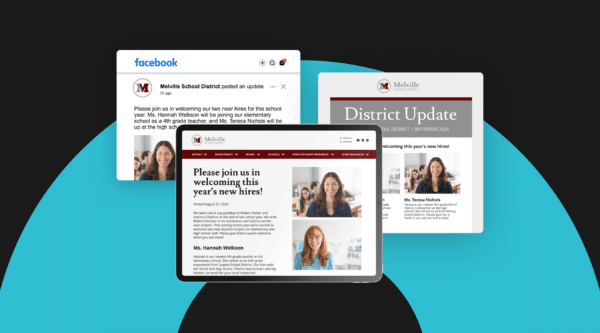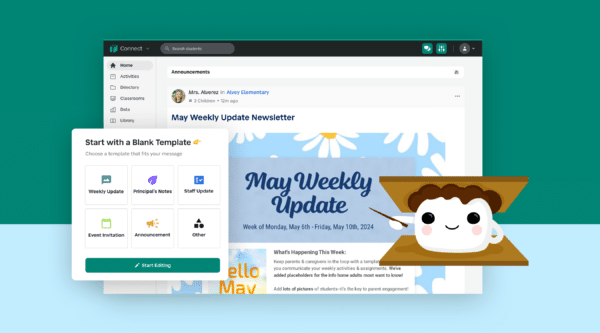

In today’s digital world, school blogs play an essential role in connecting with families, students, and the larger community. Despite their importance, many school blogs can come across as dry or unengaging, more like business letters than dynamic content. To truly connect with your audience, it’s essential to craft blog posts that are both informative and engaging.
This post will walk you through key strategies for transforming your school blog from a passive page into a lively communication tool that helps foster connections within your school community.
1. Prewriting: Research and Brainstorm
Every good writing assignment starts with pre-writing. You may have an idea in mind, or might just be kicking around some topics. Through research, brainstorming, mind mapping, and free writing (not to be confused with your first draft) on the topic, you can start to zero in on the message you want to convey.
TIP: be specific, don’t get too comprehensive, or allow the topic to ‘creep’ away from the topic at hand.
Before you start writing, take the time to research and brainstorm ideas. Consider your audience—families, students, teachers, and staff—and think about topics that will resonate with them. Popular themes may include school events, educational trends, or tips for students and families navigating challenges like remote learning.
Tip: Keep your content focused. A clear, specific topic makes for a more engaging and understandable blog post. For example, instead of tackling broad issues like “education trends,” narrow it down to something more actionable like “5 Key Trends in Virtual Learning.”
Pro Tip: Use Tools to Track Engagement
For effective engagement, use tools like SchoolStatus to measure what your audience responds to most. This data-driven approach ensures your blog posts are on-target and relevant.
2. Create a Clear Outline
A well-organized outline is essential for writing a cohesive blog. Begin with your central idea and then break it into key sections. Here’s a basic structure to guide you:
- Introduction: Briefly introduce the topic and explain why it’s important.
- Body: Present your main points logically, using subheadings to break up the text.
- Conclusion: Summarize your key points and include a call to action (CTA).
A clear outline not only helps you stay on track but also ensures your readers can easily follow your train of thought.
3. Craft an Attention-Grabbing Title
Your title is the first thing readers will see, so it needs to be compelling. Use a title that clearly communicates the subject of your post while also incorporating relevant keywords for search engine optimization (SEO). For example, instead of a generic title like “School Fundraiser,” try something more attention-grabbing like “5 Proven Strategies to Boost Your School’s Fundraiser.”
SEO Tip: Incorporating SEO-friendly keywords like “school communication tips” or “family engagement strategies” can help your post rank higher in search results, making it easier for your audience to find your content. You can use tools like Google’s Keyword Planner to identify the best keywords for your school blog.
4. Hook Your Readers with a Strong Introduction
The introduction is your chance to capture your reader’s attention. Start with a surprising fact, anecdote, or question that aligns with your topic. For instance, if your post is about improving family-teacher communication, you could begin with something like:
“Did you know that schools with strong family-teacher communication have students who perform up to 30% better academically?”
A strong hook ensures your readers stay engaged and are motivated to keep reading.
5. Provide Actionable and Relevant Content
The body of your blog should deliver valuable, actionable insights that readers can apply. Break up large blocks of text with headings, bullet points, or numbered lists. This improves readability and helps convey information more effectively.
For example:
- Use Short Paragraphs: Large blocks of text can be overwhelming. Shorter paragraphs improve readability, especially on mobile devices.
- Incorporate Visuals: Where applicable, use images or infographics to break up the text and engage your readers visually. Tools like Smore can help you create visually appealing newsletters or blog posts.
Linking Strategy: Include both internal and external links in your post. Internal links (e.g., linking to another blog post or a resource on your school’s website) can guide readers to more information on your site, boosting page views. External links to credible sources (such as education statistics from government sites) build trust and credibility while improving SEO.
6. Summarize and Reinforce Key Points
In your conclusion, briefly recap the main points of your blog post. This helps reinforce the takeaways for readers, especially for those who may have skimmed through the article.
For example, if your blog is about family engagement, your conclusion might read: “In summary, building strong family-teacher communication can improve student performance, foster a better school culture, and create a more supportive learning environment.”
By restating the main ideas, you help ensure your readers leave with a clear understanding of the topic.
SEO Tip: A well-structured conclusion not only improves readability but also enhances your post’s SEO. Google favors content that is comprehensive and easy to navigate, and readers who stay engaged are more likely to share your content or explore other pages on your website.
7. End with a Strong Call to Action
A good blog post always ends with a call to action (CTA). Whether it’s encouraging readers to sign up for your school newsletter, share the post on social media, or register for an upcoming event, a clear CTA drives further engagement.
For instance: “Want to stay updated on the latest school news? Subscribe to our newsletter!”
Effective CTAs can drive more traffic to other areas of your site or increase participation in school events. Don’t underestimate the power of a strong conclusion that encourages interaction.
Pro Tip: Use Automation Tools for Follow-Ups. For more efficient communication, tools like SchoolStatus offer automated follow-up messaging and engagement tracking, ensuring your CTA converts into meaningful action.
Final Thoughts
Writing a compelling school blog doesn’t have to be daunting. By following these steps—conducting research, crafting a clear outline, using a strong title, hooking readers with an engaging introduction, providing actionable content, summarizing key points, and ending with a CTA—you can turn your blog into a powerful tool for communication and engagement.
Looking to improve communication within your school community? Explore SchoolStatus and Smore for tools to streamline your messaging and foster stronger connections.
Stay Connected
News, articles, and tips for meeting your district’s goals—delivered to your inbox.





